- Europe is shifting its energy landscape, aiming for independence from Russian energy, with a focus on renewable resources.
- By 2025, the EU plans to add 89 gigawatts of renewable energy, primarily from solar (70 gigawatts) and wind (19 gigawatts).
- Solar innovation is evident, from mandated solar panels in French car parks to balcony installations in Germany.
- Spain has significantly increased its solar capacity and is the EU’s second-largest renewable energy producer.
- Italy leverages its geography for substantial contributions to solar energy.
- Challenges include prolonged legal processes for wind farms and global supply chain issues.
- Europe’s resilience and innovation aim to achieve energy independence by 2027, setting an example in environmental stewardship.
A quiet yet profound shift is sweeping across Europe, transforming its energy landscape with a bold vision. As tensions persist in Eastern Europe, the European Union is determined to break free from the chains of reliance on Russian energy, lighting the path to a greener future with unparalleled determination.
The impending addition of a staggering 89 gigawatts of renewable energy by 2025 shines a beacon over the continent. This surge, predominantly spearheaded by solar energy with 70 gigawatts, and attended by 19 gigawatts from wind, marks an unparalleled leap toward sustainability. Imagine sprawling solar arrays glinting in the sunlight, juxtaposed against the aged architecture of historic towns—this imagery is set to become the new normal.
Take a stroll through French cities where vast car parks are now mandated to bear solar panels, turning ordinary spaces into hubs of energy innovation. In Germany, residents creatively drape solar panels over their balconies, a grassroots movement that has seen over half a million installations in a year. This eclectic embrace of solar power demonstrates how utility can seamlessly blend with urban life.
The sun-drenched plains of Spain and Italy have long whispered promises of solar potential. Now, those whispers resonate loudly as Spain, the powerhouse of Southern Europe, has amplified its solar capacity eightfold since 2008. Spain’s relentless pursuit places it on the podium as the second-largest producer of renewable energy within the EU. Italy, not to be overshadowed, optimizes its sunlit terrain, fueling an energy transformation that far exceeds its national size.
Despite these leaps, the road to a renewable utopia isn’t without its hurdles. The shadows of protracted legal processes loom over wind farm developments, often stretching projects by unnecessary years. Meanwhile, echoes of global market uncertainties and supply chain disruptions hint at the fragility underlying this green revolution.
Nevertheless, Europe’s commitment to redefining its energy matrix in the face of adversity is a lesson in resilience and innovation. As the continent draws nearer to its 2027 pledge of independence from Russian energy, each solar panel and wind turbine marks a step closer to not just a sustainable Europe, but a beacon of environmental stewardship for the world.
As Europe treads this transformative path, it teaches us a timeless lesson: that challenge begets change, and change—when pursued with purpose—heralds a brighter future. Now is the time to harness that inspiration, transform challenges into opportunities, and pivot our own lives toward a sustainable tomorrow.
How Europe Is Pioneering a Green Energy Revolution You Can Learn From
The Transformation of Europe’s Energy Landscape
The move towards renewable energy in Europe is not just a regional shift, but a part of a global trend towards sustainability. By 2025, Europe is set to add 89 gigawatts of renewable energy, primarily through solar and wind power. This shift is crucial in reducing dependence on Russian energy, with solar energy leading at 70 gigawatts and wind contributing 19 gigawatts.
The Surge in Solar Power
1. Solar Innovations: In France, solar panels on car parks transform everyday spaces into energy powerhouses. Germany has seen a surge in grassroots initiatives, with solar panels installed on balconies, totaling over half a million in a single year.
2. Southern Europe’s Potential:
– Spain: With an eightfold increase in solar capacity since 2008, Spain ranks as the EU’s second-largest producer of renewable energy.
– Italy: Leveraging its terrain, Italy’s solar initiatives align with its national energy transformation goals.
Challenges in the Renewable Transition
Despite progress, Europe faces challenges such as:
– Regulatory Hurdles: Legal processes for wind farms can significantly delay projects.
– Market Uncertainties: Global supply chain disruptions pose a risk to continuous energy transitions.
Strategic Recommendations
– Streamline Legal Processes: Accelerating approval processes for renewable projects could enhance efficiency.
– Enhance Infrastructure: Investing in robust supply chains can mitigate disruption risks.
How-To Steps to Emulate Europe’s Success
1. Adopt Renewable Technologies: Homeowners and businesses should consider integrating solar technologies, leveraging government incentives where available.
2. Community Initiatives: Follow Germany’s example—community solar programs enable collective investment in renewable projects.
3. Policy Advocacy: Advocate for policies that bolster renewable energy projects and streamline regulatory landscapes.
Future Trends
– Innovation in Solar Tech: Expect advancements in solar panel efficiency and integration into building designs.
– Energy Independence: Europe’s 2027 target to reduce reliance on external energy sources will likely inspire global shifts in energy strategies.
Conclusion
Europe’s renewable energy shift underscores lessons in perseverance and innovation, offering a blueprint for sustainability initiatives worldwide. By staying informed and proactive, individuals and communities can contribute to a cleaner, greener future.
For more insights on Europe’s renewable energy initiatives, visit the official website of the European Union.
